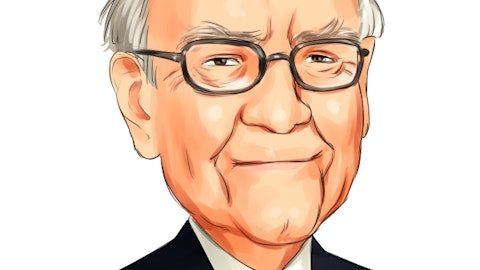Bill W. Wheat: I think on balance it’s going to balance out to 22.6% to 23.1%.
Paul J. Romanowski: And we still sell a large portion of our homes inter-quarter. So 35% to 40% is our kind of historical average. And so those are being sold now and as we look through the quarter and into the Spring selling season. So certainly, as the Spring selling season emerges and continues, it’s going to give us better visibility as we look towards the end of this quarter in to 3Q.
Michael Rehaut: Great, appreciate it. Thank you.
Operator: Your next question is coming from Truman Patterson with Wolfe Research.
Truman Patterson: Hey, good morning everyone. Not to beat a dead horse here, but I just want to understand kind of your old philosophy and some near-term dynamics with rates coming below, a little bit below 7%. I realize there’s this hedging noise, but have you all been able to kind of pull back on core incentives, if you will, the past several weeks or is this much more taking kind of a bit of a wait-and-see approach, I think you mentioned a good rebound early in the year, are you taking a wait-and-see approach, so you’re not disrupting kind of demand or the momentum ahead of the Spring selling season?
Paul J. Romanowski: Truman, I think that as we look at this today, it’s still very early. And for us, consistency of activity has been important. So we haven’t made any significant changes in our incentives if the market gives this to us, and we continue to see the early encouragement that we are, then we’ll respond to the market in kind. If rates continue to stay up, then we’ll need to lift our rate offerings like we’ve done in the past and will fluctuate as those rates move. Still it has been our best incentive is the rate buy down and consistency of rate, consistency of payment to our buyers as they shop in market.
Jessica Hansen: And all of that continues to be managed market by market, community by community based on what our local operators are seeing and believe it’s the best to drive the strongest returns. I mean, even with a little bit of giveback in our gross margin, our improved cycle times and what we’re going to turn this year in terms of inventory is way more important to our bottom line and the returns we’re going to generate than giving up a little bit of gross margin and still being at roughly 23%.
Truman Patterson: Makes total sense. And with that, you all bumped your closings guidance a little bit to about 89,000 around there. That’s well above the prior peak of, we’ll call it, 83,000 back in 2022 when there were all of these supply chain issues and constraints. Could you just help us get a little more comfortable with that level of growth kind of based on today’s labor pool, a lot availability. I’m really trying to understand constraints today and maybe what level of closings would really create bottlenecks in the construction process, not asking about demand or anything along those lines?
Michael J. Murray: We’ve been very focused on creating a quarter-to-quarter consistent starts plan where we’re feeding our neighborhoods with lots that are available in front of us and making sure we have those lots supplied and secured to us. At the same time, we’ve made a tremendous amount of progress reducing our cycle times and coming back to sort of our historical norms of around four months from starting a home to completion. And so that’s giving us much greater flexibility going into this year with the strong finished lot position we currently have, combined with the reduced cycle times, we’re able to reduce our homes in inventory and still deliver a closing target that’s going to be at or in excess of our two times beginning of the year housing terms.
So we really feel good about what’s happened there. As to what the upside top side is where the bottlenecks would come in, hard to speculate on where that would be. We feel really good about our lot position, neighborhood by neighborhood and the trade partnerships that we have and the supplier relationships that we have, they’ve been very supportive of us.
Jessica Hansen: But great point, Truman, and that when we think about overall industry constraints, finished lots are going to continue to be an issue in terms of builders being able to put more houses on the ground today. It’s not getting any easier to put a finish lot on the ground and so we continue to have a focus on building out our lot position and our relationships with third-party developers to make sure we’re positioned for growth. But when we think about the biggest constraints to the industry overall, it definitely starts with finished lots.
Truman Patterson: Perfect. Thank you all and good luck in the coming year.
Operator: Your next question is coming from Eric Bosshard with Cleveland Research.
Eric Bosshard: Good morning. Curious if you can provide a little bit of perspective. You talked about favorable trends into the Spring and 56% first time. Just as you look across the business, in terms of where you’re seeing relative strength in regards to price points and product where things are above average and where things are below average?
Michael J. Murray: I think it’s pretty consistent across the board. We’re feeling really good across all of our offerings. I mean as 55% to 56% of our deliveries have been to first-time homebuyers, that’s generally where we’ve kind of geared our neighborhoods that we’re positioning and the product that we’re positioning with that. I think 70% of our deliveries were at $400,000 or less, which for us is maintaining a focus on affordability and a payment that works for people in their monthly budget. Hence, we’ve used the interest rate buy downs quite a bit. But feel really good. Coming out in January does not make a quarter or a Spring selling season, but we’re very encouraged by the early trends in January and are excited for what the spring is going to hold.
Eric Bosshard: From a product perspective or price point perspective with lower rates, do you think differently than you did 90 days ago in terms of focus on affordability or do you think about expanding a bit more what you’re doing?





